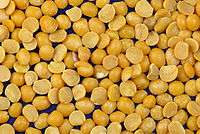Split pea
|
Yellow split peas | |
| Nutritional value per 100 g (3.5 oz) | |
|---|---|
| Energy | 1,425 kJ (341 kcal) |
|
60 g | |
| Sugars | 8 g |
| Dietary fiber | 26 g |
|
1 g | |
|
25 g | |
| Vitamins | |
| Thiamine (B1) |
(61%) 0.7 mg |
|
(34%) 1.7 mg | |
| Folate (B9) |
(69%) 274 μg |
| Minerals | |
| Iron |
(31%) 4 mg |
| |
|
Percentages are roughly approximated using US recommendations for adults. Source: USDA Nutrient Database | |
Split peas are an agricultural or culinary preparation consisting of the dried, peeled and split seeds of Pisum sativum.
Harvesting
They are peeled, in that in addition to not being in the seed pod in which they grew, the splitting process also removes the dull colored outer skin of the pea. They come in yellow and green varieties. The peas are round when harvested and dried. Once dry, after the skin is removed, the natural split in the seed's cotyledon can be manually or mechanically separated, in part to encourage faster cooking due to increasing the surface area exposed to heat.
In markets, both the green and the yellow varieties of split pea are found in their respective selections, bagged by color. These two colors reflect some of the work of Gregor Mendel, who studied the inheritance of seed color in peas. The green phenotype is recessive to the yellow one. Traditionally, the genotype of purebred yellow is "YY" and that of green is "yy", and hybrids of the two, "Yy", have a yellow (dominant) phenotype.
Split peas are high in protein and low in fat, containing only one gram of fat per 350 calories (1,500 kJ) serving. Most of the calories come from protein and complex carbohydrates. The split pea is known to be a natural food source that contains some of the highest amounts of fiber, containing 26 grams of fiber per 100 gram portion (104% DV based on a 2,000 calories (8,400 kJ) diet). Fiber is known to help the digestive system and to make people feel full and satiated.
Yellow split peas may sometimes be confused with the Indian toor dal (split pigeon peas) or chana dal (split yellow gram, desi chickpeas); while all are commonly known as peas, the latter are from other legume species.
In Cyprus, the green leaves are very popular in winter. They are eaten raw with bread and olives, or used in salads.
In the Caribbean, it is a key ingredient in many Indian meals.
Uses
.jpg)
Green and yellow split peas are commonly used to make pea soup or "split pea soup", and sometimes pease pudding, which was commonly prepared in Medieval Europe.
In north India, they are generally known as matar ki daal, sometimes used as a cheaper variation for the very popular chhole on stalls offering it.
Yellow split peas are most often used to prepare dhal in Guyana, Trinidad and the Fiji Islands. Referred to as simply dhal, it is prepared similarly to dhals found in India, but also may be used in a variety of other recipes. Yellow split pea is the main ingredient of the Iranian food "khoresh gheymeh", which is served on the side of white rice in Iranian cuisine. It is also an important ingredient in the famous Tabriz köftesii, a kofta speciality from Northern Iran,
Yellow split peas are used to make a sweet snack in Beijing cuisine. Wandouhuang (豌豆黄) is a sweetened and chilled peas pudding, sometimes flavored with osmanthus blossoms and dates.
In Europe, the Greek "Fava" is a dish made with yellow split peas pureed to create an appetizer or meze.
See also
- Dal
- Horsebread
- Marrowfat peas (type of dried whole pea)
- Pigeon pea
